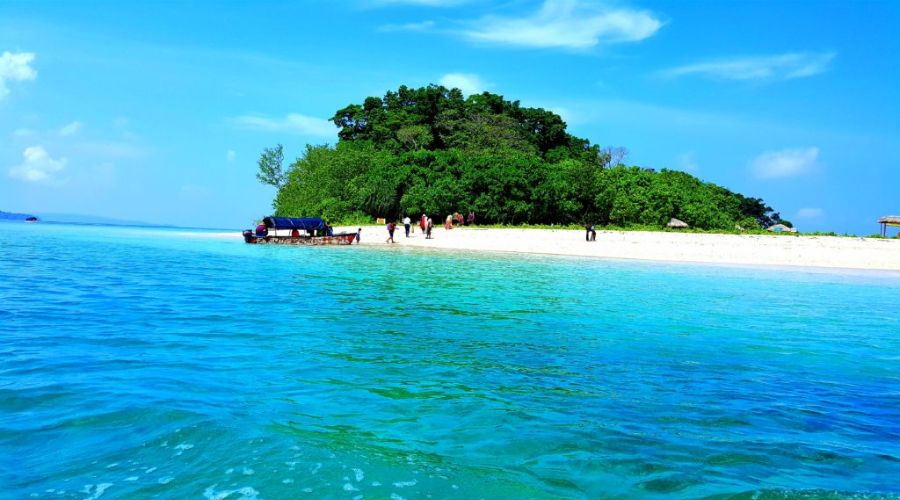Sea Walking in Andaman Islands: Overview
Sea walking is a thrill; it is an adventure for life. Because it doesn’t require any special skill, it can be easily attempted by all. Sea walking makes for a marvellous activity where you get to walk on the ocean floor, typically around a depth of 7 to10 meters, while wearing a special helmet that allows you to breathe. Sea walking does not require any complicated training or equipment like oxygen tanks or wetsuits. You just wear the helmet, which allows you to breathe naturally, and walk on the seabed as you enjoy the vibrant marine life around you. As you walk on the ocean floor you would be able to breathe normally through the specially designed helmet that ensures a steady oxygen supply. The experience is designed to be safe and comfortable, even for non-swimmers, as the equipment allows participants to walk comfortably on the seabed so that you can explore coral reefs, tropical fish and other marine life. Trained guides accompany participants during the activity.
Suggested Read: Kayaking in Andaman and Snorkelling in Andaman
How Does Sea Walking Work
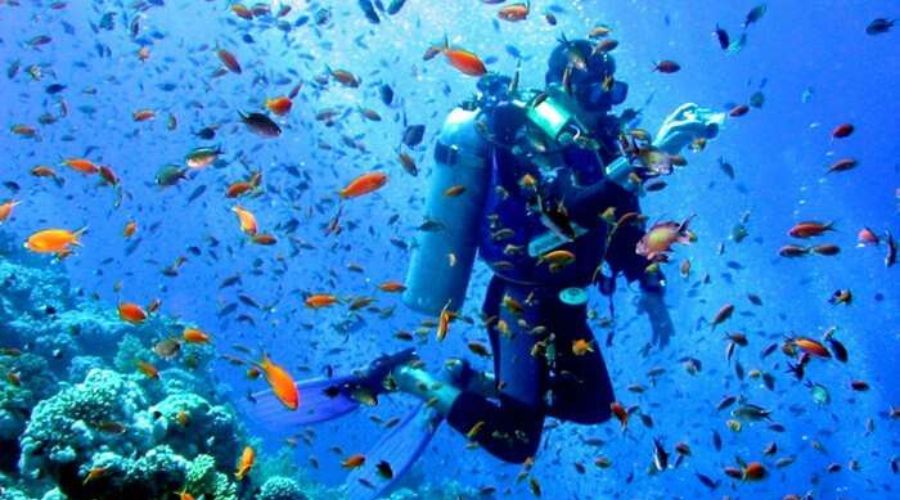
Sea walking is an underwater activity that allows people to walk on the seafloor even while breathing normally, using a specially designed helmet. The helmet used in sea walking is airtight and connected to an oxygen supply on the surface, allowing the adventurer to breathe normally. The design keeps water from entering the helmet while providing a clear view of the surroundings. It weighs enough to counteract buoyancy but not so much that it makes walking difficult.
The helmet is attached to a tube that supplies oxygen from the surface, which enables people to breathe without having to depend on scuba gear or an air tank. You don’t even have to learn the technique of breathing in and out as is done in scuba diving. The helmet remains dry inside, and participants are exceptionally carefree as they do not have to worry about learning how to breathe. The sea walking activity typically takes place in shallow waters that are about 3 to 7 meters deep) near coral reefs or areas with rich marine life. Participants walk on the seabed, usually along a guided path, to explore marine life up close. Participants wear weights to help them stay grounded on the seafloor. These weights prevent them from floating up due to the natural buoyancy in water.
A guide or professional instructor usually accompanies sea walkers to ensure safety, providing instructions on movement and helping navigate any obstacles. You get clicked and form rings and hover close to the guides who have trained eyes to spot the usual and the attractive under the surface. That way you ensure that you don’t miss any special viewing. It is a great way for non-swimmers or those who don’t want to scuba dive to experience underwater life!
Suggested Read : Andaman tour packages
Locations in Andaman for Sea Walking
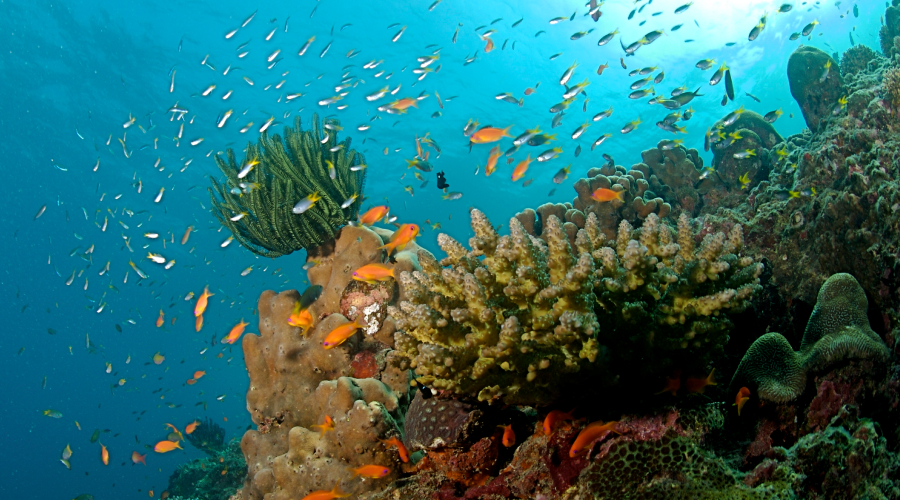
The Andaman Islands, located in the Bay of Bengal, are famous for their pristine beaches and vibrant marine ecosystems. The water clarity and the abundance of coral reefs make the Andamans an ideal location for sea walking. These locations have well-organized sea walking tours with trained guides, proper safety equipment and high-quality helmets. This ensures a comfortable and enjoyable experience for tourists who are new to underwater activities. Some popular spots for sea walking can be identified as follows:
Suggested Read : Top 5 things andaman
- North Bay Island: is known for its colourful coral reefs and rich marine biodiversity. This is one of the most spectacular places for sea walking. North Bay is just a short boat ride from Port Blair, the capital city of the Andaman Islands. This proximity makes it an easy and convenient location for tourists to experience sea walking, often as part of a day trip. Sea walking at North Bay offers a safe and beginner-friendly alternative to scuba diving or snorkelling. Even non-swimmers can enjoy this underwater activity with the help of trained professionals, making it accessible to a wider audience. North Bay is home to stunning coral reefs that are easily accessible in shallow waters. These reefs are teeming with colourful corals, sea anemones and diverse marine life, providing an amazing underwater experience for sea walkers. Sea walkers enjoy viewing schools of tropical fish, including parrotfish, clownfish and angelfish, among others. The clear water and variety of marine life make it an ideal spot for an immersive sea walk.
- Elephant Beach: in Havelock Island is another favourite spot for sea walking. Havelock Island is renowned for its crystal-clear waters and offers a fantastic experience for adventure seekers. The sheltered location of Elephant Beach makes the water calm, reducing any risk of strong currents or waves, which makes the experience safe and enjoyable. This calm environment allows tourists to focus on the underwater beauty during their sea walk. Elephant Beach is just a short boat ride from the main jetty of Havelock Island, one of the most popular tourist destinations in the Andamans. It is easy access makes it a convenient spot for tourists who want to engage in water activities like sea walking, snorkelling and scuba diving. Sea walking at Elephant Beach is designed to be a fun and safe experience, even for those who have never tried underwater activities before. Trained guides accompany tourists, making sure they feel comfortable and secure throughout the walk. Elephant Beach is not just known for its underwater beauty; it also has a scenic coastline with white sandy beaches and crystal-clear blue waters. The combination of stunning underwater and over-water views makes for a memorable overall experience.
- Neil Island: is a quieter and less crowded option, Neil Island also offers beautiful coral reefs and a relaxed vibe for sea walkers. The shallow waters around the island offer a thriving underwater ecosystem, making it ideal for sea walking. Tourists can easily witness vibrant corals and marine life up close without having to dive deep. The waters around Neil Island are teeming with marine biodiversity. Sea walkers can encounter various species of colourful tropical fish such as clownfish, butterflyfish and parrotfish. Sea cucumbers, starfish and other marine creatures also inhabit the area, offering a rich underwater experience. The seabed here is easy to navigate and does not require advanced swimming skills, which makes sea walking accessible for everyone, including non-swimmers. Compared to more popular destinations like Havelock Island, Neil Island is relatively quieter and less commercialized. This means the underwater environment is more pristine, offering a more tranquil and less crowded sea walking experience. Neil Island has professionally organized tours that follow strict safety and environmental guidelines. This ensures that the underwater experience is not only enjoyable but also eco-friendly, preserving marine life and corals for future visitors.
Suggested Read : Camping in andaman
What to Expect in Sea Walking in Andaman
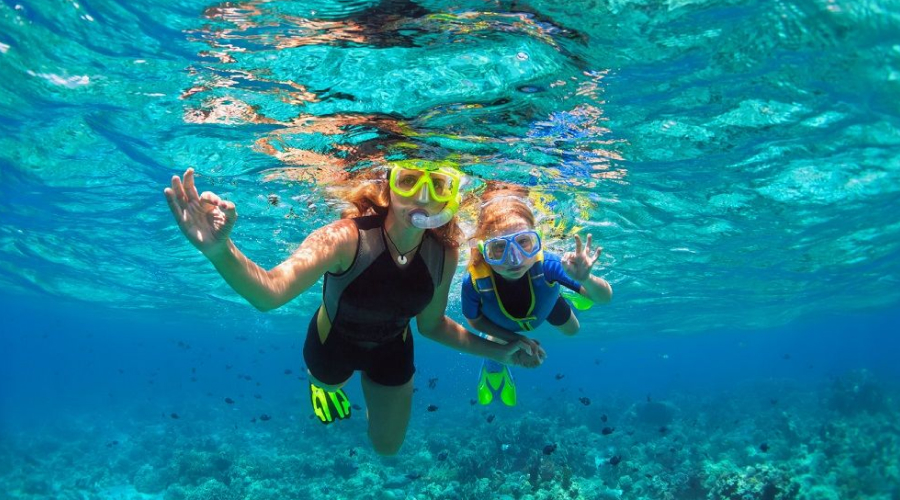
If you love exploring the exquisite underwater would, sea walking can be the best and most relaxing. Sea walking offers an opportunity to see the underwater world up close, including colourful corals, tropical fish and other marine creatures like sea cucumbers, starfish and sometimes even small stingrays. One of the best things about sea walking is that it doesn’t require any prior swimming or diving experience. Even non-swimmers can enjoy the experience. Before heading underwater, there’s a brief orientation to make sure participants understand the procedure and safety instructions. The helmet is specially designed to keep your head dry, and trained guides are present throughout the activity to ensure a safe and enjoyable experience.
Suggested Read : Solo trip in andaman
Who Should Avoid Sea Walking in Andaman
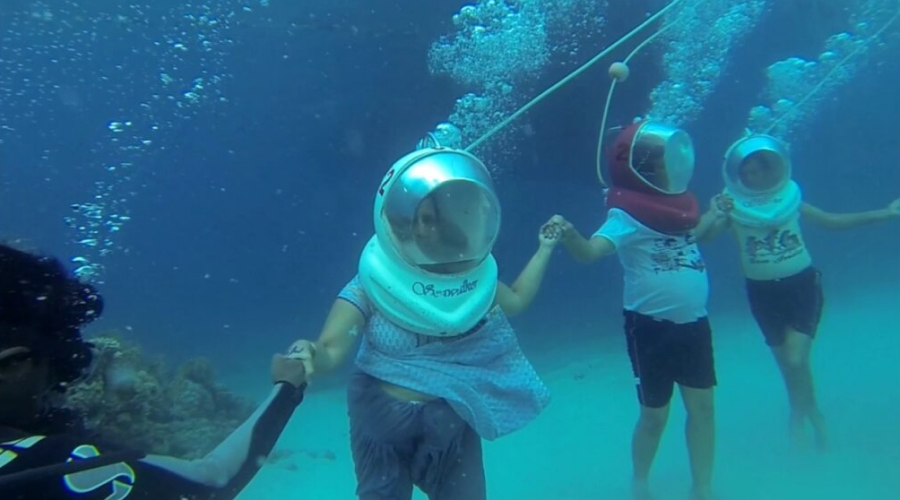
- People with Respiratory Issues severe asthma or other chronic respiratory conditions should avoid sea walking, as being underwater and in a helmet can cause difficulty breathing.
- Those with any form of lung disease, such as Chronic Obstructive Pulmonary Disease (COPD), are advised not to engage in sea walking.
- Individuals with heart conditions, such as cardiovascular diseases or a history of heart attacks, should avoid this activity due to the stress it can place on the heart while underwater.
- Those who are suffering from Hypertension (High Blood Pressure can also be risky in an underwater environment where sudden changes in pressure can affect blood circulation.
- It is generally advised that pregnant women avoid any underwater adventure, including sea walking, due to the physical strain and potential risks associated with changes in pressure and emergency situations.
- Individuals who currently have or are prone to ear infections should avoid sea walking, as water pressure can aggravate their condition.
- Anyone who has trouble equalizing pressure in their ears (e.g., those prone to ear barotrauma or Eustachian tube dysfunction) may find it difficult to manage the pressure changes underwater.
- People who suffer from claustrophobia or severe anxiety might find the enclosed helmet and underwater environment uncomfortable or panic-inducing.
- Though sea walking helmets are designed to let you breathe easily, the experience of being underwater and isolated from the open air can be distressing for some.
- People with a history of epilepsy or seizures should avoid sea walking, as an episode underwater could be life-threatening.
- Those with ongoing sinus infections or sinus congestion should avoid this activity because pressure changes during the descent can cause discomfort or injury to the sinuses.
- Most providers have an age restriction for safety reasons, and children below 10-12 years of age are typically not allowed to participate in sea walking due to the size of the helmets and safety concerns.
- Anyone who is intoxicated or under the influence of drugs should avoid sea walking. Being impaired can affect your judgment and ability to follow safety instructions.
- If you have recently undergone surgery, especially ear, sinus, heart, or lung surgery, it’s important to avoid sea walking. Recovery from such procedures might be compromised by the underwater pressure and physical exertion.
- Individuals with recent fractures or injuries, particularly to the legs, back or neck, should consult a doctor before attempting the activity.
- Those with severe or uncontrolled diabetes should avoid sea walking due to potential risks related to sudden drops in blood sugar or the possibility of a medical emergency underwater.
- Before participating in sea walking, it’s always a good idea to consult with your doctor, especially if you have any underlying medical conditions. Most sea walk operators also require participants to fill out a medical questionnaire to ensure safety. Being mindful of these risks helps ensure that the experience remains safe and enjoyable for everyone!
Suggested Read : Kayaking in andaman
Sea Walking in Andaman: Duration and Cost
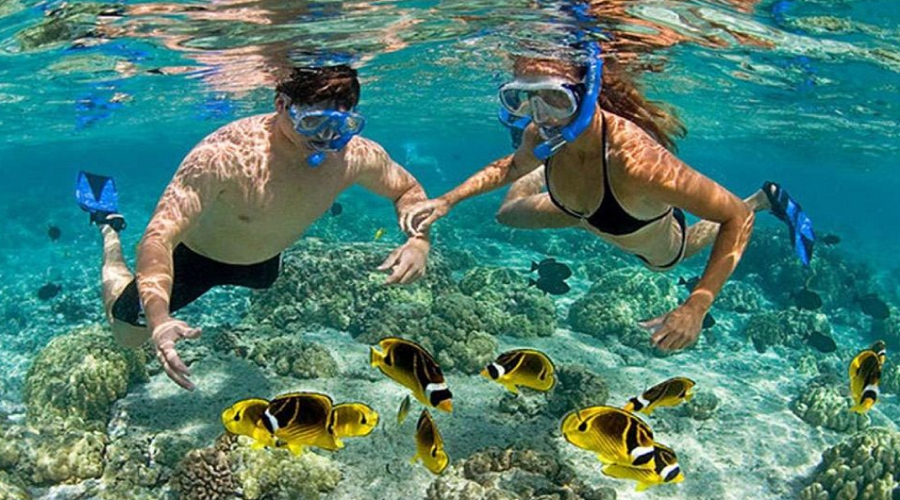
- The actual sea walk usually lasts for about 20-30 minutes, although the total experience, including briefings and travel time by boat to the sea walking platform, can take 1-2 hours.
- Costs can range between INR 3000 and INR 5000 per person, depending on the location and service provider.
Best Time for Sea Walking in Andaman
The ideal time for sea walking in the Andamans is between October and May. During this period, the sea remains calm and the weather is pleasant, offering good visibility underwater.
Additional Tips
- Wear comfortable beach attire or swimwear.
- Avoid touching or stepping on corals during the walk as they are fragile ecosystems.
Sea walking in the Andaman Islands is a perfect way to explore the fascinating underwater world for those who may be uncomfortable with diving but still want to experience the thrill of marine life!


